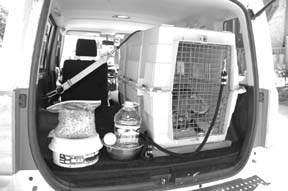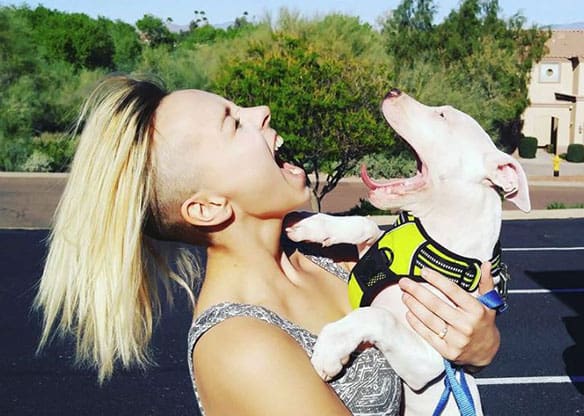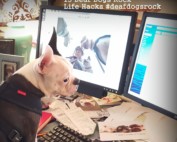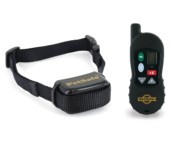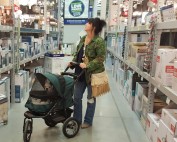I used to drive around with my deaf dog Nitro without a crate or a restraint in my car until I read statistics and rates of speed a dog’s body can travel (flying through the air becoming a projectile) during impact so now we do have a big crate in our SUV to keep him safe.
The crate is also an added bonus so I don’t have to worry about my seats being distroyed every time I run into Star Bucks to get a Venti Mocha. Can you imagine getting in a wreck and your hearing or deaf dog getting loose and running down the highway? Talk about losing control in an emergency situation! Since I am such a big control freak, I don’t even want to think about that possibility. I saw this article this morning on “Driving Safely with Your Dog” and I thought I would share the information that Pat Miller offered in her article on Whole Dog Journal.com because she has some great points in this article. I hope you take her advice to keep your dogs safe in the car. We want you and your dogs around for a very long time ~ Christina and Nitro – Deaf Dogs Rock
 Photo 1. – Above photo: Nitro before we used restraints on him.
Photo 1. – Above photo: Nitro before we used restraints on him.
 Photo 2. Above photo: Nitro wearing a Puppia Wondervest with a large D-ring on the back of it so we can literally clip him into any seat-belt (also see our post The Double Fail System with Puppia)
Photo 2. Above photo: Nitro wearing a Puppia Wondervest with a large D-ring on the back of it so we can literally clip him into any seat-belt (also see our post The Double Fail System with Puppia)
 Photo 3. Above photo. Now we have a large crate in the back of our SUV so when we go places with Nitro we always take this car. Chris has the crate strapped in place for extra safety measures. Nitro loves his crate in the car. The minute the car starts moving he goes right to sleep. He knows as long as he can feel the vibration of the car moving he doesn’t have to try to keep an eye on us because he knows we won’t just “disappear” into another room so he goes right to sleep.
Photo 3. Above photo. Now we have a large crate in the back of our SUV so when we go places with Nitro we always take this car. Chris has the crate strapped in place for extra safety measures. Nitro loves his crate in the car. The minute the car starts moving he goes right to sleep. He knows as long as he can feel the vibration of the car moving he doesn’t have to try to keep an eye on us because he knows we won’t just “disappear” into another room so he goes right to sleep.
Driving Safely with Your Dog by Pat Miller – wholedogjournal.com
Safety gear and calm behavior should be required for canine passengers.
When I’m driving on the road and see a dog in someone else’s car, it makes me smile. I love it when people care enough about their dogs to chauffeur them around town. I love it even more when the dog is in a crate or seat belted in place.
My smile quickly vanishes, however, if the dog has her head stuck out the window, is sitting in the driver’s lap, darting back and forth across the seats, or worse, riding loose in the back of an open pickup truck. And the ultimate crime – leaving a dog in a hot car – motivates me to grab my cell phone and call out the animal cops.
As much as we love our dogs and want them with us all the time, we have an incontrovertible obligation to transport them safely, for their own welfare as well as ours, and that of other drivers on the roads. All dogs, large and small, should learn to ride politely in their cars. There’s a long list of safety hazards concomitant with having an unrestrained obstreperous canine in a moving vehicle. Here are some:
Dogs are safest in the car when they are in a sturdy crate that is securely fastened in place, or wearing a harness and a seatbelt in the back seat of the car. Owners should carry water and a leash, and make sure their friends are wearing ID tags.
A dog who interferes with driver’s physical ability to drive the car. A dog sitting on the driver’s lap can interfere with steering. A dog who gets on or under the accelerator or brake pedals, hits the gear shift, or blocks the driver’s view can cause an accident.
A dog who interferes with driver’s mental ability to drive the car. When the driver’s attention is taken away from the road to deal with dog’s behavior, the dog has become a safety hazard.
A loose dog can become a flying missile if the car stops abruptly or is hit by another car. If the car windows break or the doors pop open in an accident, a loose dog can escape, get hit on the road, or run off and become lost. An unsecured dog can interfere with the efforts of rescue workers in an emergency.
A dog with her head out the window can suffer injury to her eyes from bits of flying debris, or worse, can have her head smashed by objects that pass too close to the car (other vehicle mirrors, signs, branches). A loose dog can fall or jump out of an open window or back of a truck. The temperature in a parked car on a warm (not even hot!) day can kill a dog.
I’m probably missing some, but I hope that’s enough to make you stop and think next time you’re planning an outing with your furry friend. That doesn’t mean you have to leave your dog buddy at home; there are lots of options for keeping everyone safe while enjoying canine company in your car. Reducing the risk
Not every dog loves car outings. Some high-risk car behavior is a result of canine stress and/or arousal. Reducing stress and arousal will decrease car-ride risks and increase car-ride enjoyment for both of you.
Tools and techniques for reducing stress in the car include covering your dog’s crate to reduce sensory stimulation; using a Calming Cap (see “Now You See It, Now You Don’t,” next page) for the same purpose; and incorporating a program of counter-conditioning and desensitization to overcome your dog’s car-related fears and arousal triggers (see “Road Scholar,” May 2001).
Additional tools for maximizing your car safety and pleasure are those that restrict your dog’s movement about the cabin. Many dog owners choose crating as a relatively safe car restraint option. This can be an excellent choice, and it does have drawbacks. To be super-safe, the crate needs to be fastened securely in the back of the vehicle.
Space is another consideration. Crates require a lot of room. If you have a mini-car and a maxi-dog, there’s no room for a crate – you need to explore other options, like canine seat belts. When the “fasten your seatbelt” sign lights up on your dashboard, so can your dog’s. Many dogs ride comfortably and calmly secured in their seats with a belt designed for just that purpose. There are numerous models to choose from. (See “Seat Belt Your Dog,” February 2004.)
To avoid the potential for serious injury to his neck, though, be sure to select one that attaches to a harness, not your dog’s regular collar. Some dogs who habitually pace nervously back and forth in their cars settle down and relax when restricted by a seat belt. It’s easier on your nerves, too! If you choose the seat belt route, be aware that the air bag danger that precludes small children from riding in the front passenger seat applies to dogs, too. Either disable your passenger air bag so Rover can ride in the front, or strap him into his seat belt in the back seat.
There are dogs who are not good seat belt candidates – typically puppies, young dogs, and others who might be tempted to try their teeth out on the seat belt or harness straps. Reprimanding your dog for chewing his belt comes under the “driver distraction” risk category. You can try applying a sour-tasting product such as Bitter Apple to the straps. This works for some dogs – but not all.
Another solution for strap chewers is a tasty stuffed Kong or other chew to keep their teeth otherwise occupied (see “King Kongs,” October 2000). You’ll need to secure the Kong so it doesn’t fall off the seat out of reach of your dog, by running a cord through the hole at the small end and tying it to a handy spot in the car. If that doesn’t work, you may need to give in and buy a bigger vehicle to accommodate a crate, or settle for a physical barrier. You might also teach your dog to love a basket muzzle and have him wear one while he’s belted in the back.
To read the full article in WholeDogJournal.com, please click here.
–Pat Miller, CPDT, is Whole Dog Journal’s Training Editor. Miller lives in Hagerstown, Marland, site of her Peaceable Paws training center. For book purchasing or contact information, see “resources”.

